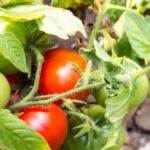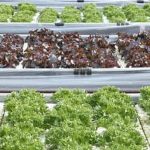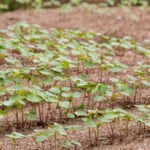Diatomaceous earth is a versatile and widely-used substance that has gained popularity in various industries. But can it also be used in vegetable gardens? In this article, we will explore the potential benefits and applications of diatomaceous earth specifically in vegetable gardens.
To begin, let’s understand what diatomaceous earth actually is. It is a naturally occurring sedimentary rock that is formed from fossilized remains of microscopic single-celled organisms known as diatoms. These diatoms have hard shells made of silica, and when they die, their shells settle on the ocean floor and eventually become compressed into the rock we call diatomaceous earth.
The importance of diatomaceous earth extends beyond its geological origin. It has found a place in numerous industries such as agriculture, filtration, cosmetics, and even pest control. Its unique properties make it an effective tool for pest control due to its ability to damage the exoskeletons of insects and dehydrate them.
In the next sections of this article, we will delve deeper into how diatomaceous earth can benefit vegetable gardens, its mode of action against pests, tips for choosing the right type for your garden, proper application techniques, common pests controlled by it, precautions to consider while using it near edible plants, and additional best practices for organic gardening alongside diatomaceous earth.
So if you’re wondering whether diatomaceous earth can be used in your vegetable garden to address pest concerns effectively and safely, read on to learn all about this natural solution with impressive benefits.
Understanding the Benefits of Diatomaceous Earth in Gardening
Diatomaceous earth, also known as DE, is a naturally occurring sedimentary rock that is formed from the fossilized remains of tiny aquatic organisms called diatoms. These diatoms have hard exoskeletons made of silica, which over time accumulate and create deposits of diatomaceous earth. Due to its unique properties, DE has become widely used in various industries such as agriculture, filtration, and pest control.
When it comes to gardening, diatomaceous earth offers numerous benefits that can help improve the health and productivity of vegetable gardens. One of the main advantages of using DE is its natural composition. It is non-toxic and safe for both humans and animals, making it an ideal choice for organic gardening. Unlike chemical pesticides, DE does not pose any harm to beneficial insects such as bees and butterflies.
In addition to being environmentally friendly, diatomaceous earth also acts as a highly effective natural insecticide. When applied to vegetable gardens, DE works by puncturing the exoskeletons of insects and causing them to dehydrate and die. This mechanism makes it especially effective against crawling insects like ants, slugs, and snails. Moreover, DE can also control pests such as aphids, mites, and even larger pests like beetles.
To fully reap the benefits of diatomaceous earth in vegetable gardens, it is important to choose the right type or grade of DE. The market offers different variations based on their particle size and purity levels. In general, DE with larger particles is more suitable for outdoor use in gardens since it offers better coverage on foliage surfaces. However, when dealing with smaller pests or indoor gardening applications such as houseplants or hydroponics systems, a finer grade may be preferred.
By understanding the benefits of diatomaceous earth in gardening and selecting the appropriate type for specific needs, gardeners can effectively utilize this natural solution for pest control while maintaining a healthy environment for their vegetable gardens.
How Does Diatomaceous Earth Work in Vegetable Gardens?
Diatomaceous Earth has gained popularity as a natural and effective solution for pest control in vegetable gardens. In this section, we will explore how exactly diatomaceous earth works to safeguard your precious plants from pests and insects.
When diatomaceous earth is applied in vegetable gardens, it acts as a physical barrier against pests. The powder-like substance is made up of microscopic fossils of diatoms, which are hard-shelled algae. These fossils have sharp edges that can puncture the exoskeletons of insects and pests upon contact. As a result, the pests become dehydrated and eventually die.
One of the main advantages of using diatomaceous earth in vegetable gardens is its mode of action, which is purely mechanical rather than chemical. This means that it does not contain any harmful toxins or chemicals that can be harmful to humans or animals. Therefore, it is safe to use on edible plants without worrying about any residue affecting the quality or safety of your vegetables.
To effectively harness the power of diatomaceous earth in your vegetable garden, it is crucial to apply it correctly. First and foremost, make sure to choose a food-grade diatomaceous earth specifically formulated for gardening purposes. These types are processed differently compared to those used in other industries, ensuring they are safe for use around plants that you intend to consume.
Once you have selected the appropriate type of diatomaceous earth, follow these step-by-step instructions for application:
- Thoroughly clean your garden area by removing weeds and debris.
- Sprinkle a light dusting of diatomaceous earth on both sides of leaves and around the base of plants.
- Reapply after rain or heavy watering as diatomaceous earth can lose its effectiveness when wet.
- Monitor your garden regularly to ensure pests are controlled effectively.
By understanding how diatomaceous earth works and applying it correctly in your vegetable garden, you can ensure effective pest control without compromising the safety and quality of your crops. In the next section, we will explore in detail the common pests and insects that can be controlled by diatomaceous earth in vegetable gardens.
Choosing the Right Type of Diatomaceous Earth for Vegetable Gardens
When it comes to using diatomaceous earth in vegetable gardens, it is important to choose the right type of product that will effectively control pests and ensure the health and safety of your plants. There are different variations and grades of diatomaceous earth available in the market, each with its own specific uses and characteristics. Here are some factors to consider when selecting the suitable type for your vegetable garden.
Variations and Grades
Diatomaceous earth products can vary in terms of their particle size, purity level, and intended use. The two main types commonly available are food grade diatomaceous earth (FGDE) and industrial grade diatomaceous earth (IGDE).
Food grade diatomaceous earth is specifically formulated for use in food production settings or applications where it may come into contact with edible plants. It has a higher level of purity and is free from any harmful contaminants or chemical additives. FGDE is safe for both humans and animals when used correctly.
On the other hand, industrial grade diatomaceous earth is primarily designed for non-food related purposes such as filtration systems or pest control in non-agricultural areas. This type may have a lower purity level and may contain additional ingredients that could be harmful if ingested.
Recommendations for Choosing
When selecting diatomaceous earth for your vegetable garden, always opt for food grade products. These ensure that your plants remain safe from any potential contaminants or toxins.
Furthermore, consider the particle size of the diatomaceous earth you choose. Ideally, look for a fine powder that will adhere well to pests’ bodies to improve its effectiveness as an insecticide. A smaller particle size also allows better coverage on plant surfaces.
It is also recommended to read product labels carefully to determine if there are any additional ingredients or additives present in the product that may not be suitable for use in a vegetable garden.
By choosing the right type of diatomaceous earth for your vegetable garden, you can ensure the safety and effectiveness of your pest control efforts while maintaining the health and vitality of your plants.
Applying Diatomaceous Earth in Vegetable Gardens
Once you have chosen the right type of diatomaceous earth for your vegetable garden, it is important to know how to properly apply it to maximize its effectiveness. Here is a step-by-step guide on applying diatomaceous earth in vegetable gardens:
- Prepare the area: Before applying diatomaceous earth, remove any weeds or debris from your vegetable garden. This will ensure that the diatomaceous earth can be evenly distributed and reach the targeted pests.
- Determine the dosage: The dosage of diatomaceous earth depends on the severity of the pest problem. Generally, a ratio of one cup of diatomaceous earth per 10 square feet of garden area is recommended for light infestations. For heavier infestations, you may need to increase the dosage.
- Apply the diatomaceous earth: Sprinkle or dust the diatomaceous earth onto the soil and plant surfaces in your vegetable garden. Pay special attention to areas where pests are commonly found, such as around the base of plants and along pathways.
- Reapply as needed: After rain or watering, it is important to reapply diatomaceous earth as it can lose its effectiveness when wet. Additionally, if you notice that pests are still present after a few days, reapply diatomaceous earth to ensure continuous control.
It is important to note that when applying diatomaceous earth, it should not be blown directly into the air as it can irritate your lungs and eyes. Therefore, avoid using mechanical dusters or blowers for application.
| Step | Description |
|---|---|
| 1 | Prepare the area by removing weeds and debris |
| 2 | Determine the dosage based on the severity of the infestation |
| 3 | Sprinkle or dust diatomaceous earth onto the soil and plant surfaces |
| 4 | Reapply after rain or watering, and if pests are still present |
By following these guidelines, you can effectively use diatomaceous earth in your vegetable garden to control pests naturally. Remember to always wear gloves and a dust mask when handling diatomaceous earth to ensure your safety.
Common Pests and Insects Controlled by Diatomaceous Earth in Vegetable Gardens
List of Common Pests in Vegetable Gardens
One of the main reasons why diatomaceous earth is popular among gardeners is its effectiveness in controlling a wide range of pests and insects that commonly infest vegetable gardens. Some of the most common pests found in vegetable gardens include:
- Aphids: These tiny insects can quickly multiply and cause damage to leaves, stems, and fruits.
- Slugs and Snails: These slimy creatures are notorious for devouring young seedlings and leaving behind unsightly trails.
- Caterpillars: Some caterpillar species, such as cabbage worms, can devastate crops by feeding on their leaves.
- Earwigs: Although harmless to humans, earwigs can eat tender plant growth and cause cosmetic damage to vegetables.
- Whiteflies: These small, white-winged insects suck sap from plants, leading to wilting leaves and stunted growth.
- Beetles: Various beetles, including flea beetles and cucumber beetles, can chew on foliage and hinder plant growth.
How Diatomaceous Earth Controls Pests in Vegetable Gardens
Diatomaceous earth works as an effective pest control solution due to its unique mode of action against insects. When sprinkled around the plants or on affected areas, diatomaceous earth acts as a desiccant and dehydrates the pests upon contact.
The sharp microscopic particles of diatomaceous earth create tiny cuts on the exoskeletons of pests, causing them to lose moisture rapidly. As a result, pests like aphids, slugs, caterpillars, earwigs, whiteflies, and beetles are unable to survive for long periods when exposed to diatomaceous earth.
Furthermore, diatomaceous earth also has an abrasive effect on soft-bodied pests like slugs and snails. The substance’s rough texture scratches their delicate skin, leading to dehydration and ultimately, death. By targeting pests in this natural way, diatomaceous earth effectively eliminates infestations without posing any harm to humans, animals, or the environment.
Proper Application Techniques and Tips
To effectively control pests in vegetable gardens using diatomaceous earth, it is important to follow proper application techniques. Start by ensuring that the garden and plants are dry, as moisture can reduce the effectiveness of diatomaceous earth. Next, sprinkle a thin layer of diatomaceous earth around the base of plants or directly on leaves affected by pests. It is crucial to reapply after rainfall or heavy irrigation to maintain its efficacy.
When applying diatomaceous earth in vegetable gardens, it is essential to wear protective gear such as gloves and a dust mask to prevent inhalation of the fine particles. Additionally, carefully read and follow the manufacturer’s instructions regarding dosage rates for specific pests and plants.
One useful tip is to concentrate diatomaceous earth application in areas where pest activity is highest or where crops are most vulnerable. For example, create barriers of diatomaceous earth around young seedlings or heavily infested areas. Regular monitoring of pest populations will help determine if additional applications are necessary.
Precautions and Safety Measures when Using Diatomaceous Earth in Vegetable Gardens
When using diatomaceous earth in vegetable gardens, it is important to take certain precautions and safety measures to ensure the well-being of both humans and plants. While diatomaceous earth is generally considered safe for use, there are some guidelines that should be followed to minimize any potential risks.
First and foremost, it is crucial to wear appropriate protective gear when handling diatomaceous earth. This includes gloves, goggles or safety glasses, a face mask or respirator, and long sleeves. These safety precautions will help protect your skin, eyes, and respiratory system from any irritation or inhalation of the fine dust particles.
It is also important to avoid applying diatomaceous earth on windy days. The fine particles can easily become airborne and may cause irritation if breathed in. Additionally, make sure to keep children and pets away from the treated areas until the dust has settled.
Furthermore, when using diatomaceous earth in vegetable gardens, it is essential to read and follow the manufacturer’s instructions carefully. Different types and brands of diatomaceous earth may have specific guidelines for application. Following the recommended dosage, frequency, and application techniques will ensure optimal results while minimizing any potential risks.
| Precautions | Safety Measures |
|---|---|
| Wear appropriate protective gear (gloves, goggles or safety glasses, face mask or respirator) | Avoid applying on windy days |
| Keep children and pets away from treated areas until dust settles | Read and follow manufacturer’s instructions carefully |
In addition to these precautions, it is crucial to consider the presence of edible plants in the vegetable garden. While diatomaceous earth is generally safe for use around vegetables, it is essential to avoid direct contact with edible parts of the plant. Applying a barrier or protective cover around the base of plants can prevent any accidental consumption of diatomaceous earth by humans or wildlife.
It is also worth noting that diatomaceous earth should not be used as a standalone solution for pest control in vegetable gardens. Integrated pest management practices should be employed, which includes regular monitoring of pests, crop rotation, and maintaining proper soil health. By combining these practices with the use of diatomaceous earth, vegetable gardeners can achieve an effective and sustainable approach to pest control.
By following these precautions and safety measures, vegetable gardeners can safely and effectively use diatomaceous earth to control pests while ensuring the well-being of their plants and themselves. Embracing this natural solution offers numerous benefits in terms of pest control efficacy and environmental sustainability.
Additional Tips and Best Practices for Vegetable Gardens
In addition to incorporating diatomaceous earth into vegetable gardens for pest control, there are several other tips and best practices that can help optimize the success of your garden. By implementing these strategies alongside the use of diatomaceous earth, you can cultivate a healthy and thriving vegetable garden.
Firstly, it is important to practice proper soil maintenance in your vegetable garden. This involves regular watering, providing adequate drainage to prevent waterlogging, and maintaining the pH balance of the soil. Diatomaceous earth can aid in moisture regulation by absorbing excess water and preventing fungal growth. However, it is essential to ensure that the soil does not become overly dry, as this can hinder plant growth.
Furthermore, practicing crop rotation is another effective technique to reduce pest populations and improve overall plant health. This involves rotating different vegetable crops in your garden from year to year, as certain pests are specific to particular varieties. By doing so, you disrupt the lifecycle of pests and minimize the risk of infestation. Diatomaceous earth can act as an additional layer of defense against pests during crop rotation.
Implementing companion planting techniques is also beneficial for vegetable gardens. Certain plants have natural repellent properties that help deter pests from infesting neighboring crops. For example, planting marigolds alongside your vegetables can repel harmful insects such as nematodes and aphids. Diatomaceous earth can be applied around companion plants to provide an extra barrier against pests.
Lastly, it is crucial to maintain good gardening practices such as removing weeds regularly and cleaning up plant debris after harvests. Weeds serve as alternative hosts for pests, so eliminating them reduces potential breeding grounds for insects. Cleaning up plant debris also removes any potential hiding spots for pests during winter months. When applying diatomaceous earth in your vegetable garden, ensure that it reaches all corners and crevices where pests may hide.
By following these additional tips and best practices alongside the use of diatomaceous earth, you can create a thriving and pest-free vegetable garden. Remember to constantly monitor your garden for signs of pests or disease, and adjust your pest control strategies accordingly. With patience and diligence, your vegetable garden will flourish, providing you with an abundance of fresh and healthy produce.
Conclusion
In conclusion, diatomaceous earth is a natural and effective solution for controlling pests in vegetable gardens. Its unique composition, derived from fossilized remains of diatoms, makes it safe to use around edible plants. By applying diatomaceous earth correctly and choosing the suitable type for vegetable gardens, gardeners can effectively control and eliminate common pests and insects.
One of the key advantages of using diatomaceous earth in vegetable gardens is its mode of action against pests. As explained earlier, diatomaceous earth works by dehydrating and damaging the exoskeletons of insects, leading to their demise. This method is non-toxic and does not harm beneficial organisms such as bees or earthworms.
Moreover, using diatomaceous earth promotes organic gardening practices. Unlike chemical pesticides that can have harmful effects on the environment and human health, diatomaceous earth provides a natural alternative that is safe for both gardeners and their produce.
Frequently Asked Questions
Can you eat vegetables treated with diatomaceous earth?
Yes, it is safe to eat vegetables that have been treated with diatomaceous earth. Diatomaceous earth is a natural product that is derived from fossilized remains of tiny aquatic organisms called diatoms.
It is commonly used in organic gardening and pest control due to its ability to deter and kill various pests like insects, slugs, and snails. When applied correctly and according to the instructions on the label, diatomaceous earth poses no harm to humans or animals, making it safe for consumption.
Is diatomaceous earth safe for tomato plants?
Yes, diatomaceous earth is generally safe for tomato plants. In fact, it can be quite beneficial for tomato plants as it helps protect them against certain pests that commonly affect these plants, such as aphids and thrips.
Diatomaceous earth works by physically drying out the exoskeleton of these insects, leading to their dehydration and death. However, it is important to note that while diatomaceous earth is generally safe for plants, it should be used sparingly and applied as directed on the packaging to avoid any potential negative effects on the plant’s health.
What kind of diatomaceous earth for vegetable garden?
When choosing diatomaceous earth for your vegetable garden, it is important to look for a food-grade option. Food-grade diatomaceous earth is specifically processed and purified to meet safety standards for use around edible crops.
This type of diatomaceous earth has undergone additional filtration processes to remove any impurities or contaminants that may be present in other non-food-grade varieties. By selecting food-grade diatomaceous earth, you can ensure that you are using a product that is safe for both your plants and potential consumption of the vegetables grown in your garden.

If you’re looking to get into vegetable gardening, or are just looking for some tips on how to make your current garden better, then you’ve come to the right place! My name is Ethel and I have been gardening for years. In this blog, I’m going to share with you some of my best tips on how to create a successful vegetable garden.





